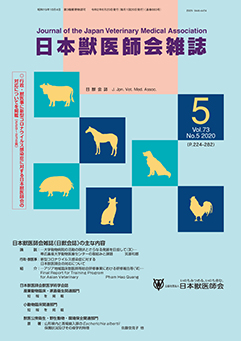
- |<
- <
- 1
- >
- >|
-
Yui HARUYAMAArticle type: Short Communication
2020 Volume 73 Issue 5 Pages 249-252
Published: June 20, 2020
Released on J-STAGE: July 20, 2020
JOURNAL FREE ACCESSIn August 2016, two grazing sheep (Corydale, 4 years old, female) were unable to stand independently, presenting with symptoms of tonic-clonic seizure and dyspnea. The blood examination results showed a marked increase in AST, ALP, CPK, GGT and LDH, an increase in total bilirubin concentration, and hypocalcemia. In the necropsy, pieces of black seeds were observed in the filtrated rumen content, which were identified as wintersweet (Chimonanthus praecox ) through genetic testing. Wintersweet seeds contain calikantin, a kind of alkaloid, and when consumed by animals, it causes nervous symptoms due to GABA inhibitory action. In addition, because a typhoon passed by the day before the onset of the symptoms, many wintersweet seeds had fallen into the pasture. Therefore, the case was considered to be toxicosis in sheep caused by the ingestion of wintersweet seeds, which was reported for the first time in Japan.
View full abstractDownload PDF (807K) -
Makoto NAKAMURA, Ryotaro HIDAKA, Shoei KITAHARA, Shun IWAO, Yoshimasa ...Article type: Short Communication
2020 Volume 73 Issue 5 Pages 253-258
Published: June 20, 2020
Released on J-STAGE: July 20, 2020
JOURNAL FREE ACCESSThree Japanese Black cows died suddenly in a herd of about 25 pregnant cows. Among that herd, six other cows developed respiratory symptoms and subcutaneous emphysema with fatal outcomes. All patient animals were fed sweet potatoes for three months prior to onset. Cows with respiratory symptoms showed elevated AST and γ-GTP, which suggested mild liver dysfunction. The gross findings in two dead cows were regression failure, emphysema and edema of the lungs, and ecchymotic spots on the surface of the liver. Microscopically we observed infiltration of macrophages and neutrophils filled alveolar spaces, proliferation of type II epithelial cells, pulmonary interstitial emphysema and localized hepatocellular necrosis. The sweet potato feed was moldy, blackened and damaged. We identified Fusarium spp. fungus from those sweet potatoes. We detected Ipomeamarone using high performance thin layer chromatography. From those results, we diagnosed this case as moldy sweet potato toxicity.
View full abstractDownload PDF (1137K)
-
Nobuhide YOSHINO, Kenichiro IKEDAArticle type: Short Communication
2020 Volume 73 Issue 5 Pages 259-263
Published: June 20, 2020
Released on J-STAGE: July 20, 2020
JOURNAL FREE ACCESSWe applied a green laser transcorneally via the anterior chamber to the ciliary body for treatment of complicated glaucoma with lens luxation in a dog. The ciliary body was able to be observed through the interspace between the iris and the dislocated lens. Intraocular pressure (IOP) stayed around 30‐38 mmHg for 3 months prior to the procedure, and 15‐21 mmHg for 3 months following the procedure, but gradually rose to 29 mmHg in the next 3 months. There was no obvious symptom of uveitis following the procedure. Although this procedure is limited to the unlikely situation where the ciliary body is observable through a narrow space, it can reduce damage to the surrounding tissue compared with transscleral cyclophotocoagulation, and can reduce the cost compared with endoscopic cyclophotocoagulation.
View full abstractDownload PDF (935K)
-
Kumiko SATO, Akiko NAGAI, Jun OBARA, Chiharu ENDO, Tetsuya HAYASHI, Ta ...Article type: Original Article
2020 Volume 73 Issue 5 Pages 265-273
Published: June 20, 2020
Released on J-STAGE: July 20, 2020
JOURNAL FREE ACCESSSwine fecal samples collected from a slaughterhouse in Yamagata Prefecture, Japan in 2017 and 2018, were examined for the presence of Escherichia albertii to determine whether swine carry this emerging zoonotic pathogen. In total, 37 E. albertii isolates were obtained from 17/525 (3.2%) cecal feces samples. Of the 37 isolates, 54.1% were resistant to one or more antibiotics, including tetracycline. The isolates were classified into 6 groups by pulsed-field gel electrophoresis. Using genome-wide phylogenetic analysis, 6 representative isolates (one from each of the 6 groups) were classified into phylogroup G1 and 2 sublineages of phylogroup G3, each of which includes human-derived strains. Therefore, our results showed that swine from Yamagata and nearby prefectures in Japan harbor E. albertii exhibiting diverse PFGE types, which suggested that swine-derived food products could be vehicles for the transmission of this pathogen to humans.
View full abstractDownload PDF (914K)
- |<
- <
- 1
- >
- >|